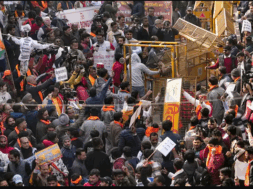
States: West Bengal’s economy declined from the early 1960s
Virendra Pandit
New Delhi: West Bengal, which held the third-largest share of national GDP at 10.5 percent in 1960-61, now accounts for only 5.6 percent in 2023-24, and has seen a consistent decline throughout this period, a government report has said.
The state, whose largest city Calcutta (now Kolkata) was the British Raj’s capital in the Indian subcontinent until 1911 and the economic hub of South Asia, has experienced a continuous decline in its relative economic performance over several decades, according to a working paper by the Economic Advisory Council to the Prime Minister (EAC-PM).
Authored by EAC-PM member Sanjeev Sanyal, the paper “Relative Economic Performance of Indian States: 1960-61 to 2023-24,” said the development of the eastern part of the country remains a concern, the media reported on Tuesday.
Maritime states have clearly outperformed other states, except West Bengal, it said.
Although Bihar’s relative position has stabilized in the last two decades, it remains significantly behind other states and requires much faster growth to catch up, the paper noted.
Conversely, Odisha, traditionally a laggard, has shown a marked improvement in recent years.
“West Bengal, which held the third-largest share of national GDP at 10.5 percent in 1960-61, now accounts for only 5.6 percent in 2023-24. It has seen a consistent decline throughout this period.
“Its (West Bengal’s) per capita income was above the national average in 1960-61 at 127.5 percent, but its growth failed to keep pace with national trends. As a result, its relative per capita income declined to 83.7 percent in 2023-24, falling below that of even traditionally laggard states like Rajasthan and Odisha,” the paper said.
The western and southern regions of India have, however, performed better than other parts of the country from 1960-61 to 2023-24.
Southern states have significantly outpaced others after economic liberalization in 1991, with the five states — Karnataka, Andhra Pradesh, Telangana, Kerala, and Tamil Nadu — collectively accounting for approximately 30 percent of India’s GDP in 2023-24.
“Before 1991, these states did not show exceptional performance. However, since the economic liberalization of 1991, southern states have emerged as the leading performers,” it said.
In addition, the per capita income of all southern states became higher than the national average after 1991.
The paper also noted that in the north, states like Delhi and Haryana also stood out. “Delhi has one of the highest per capita incomes throughout the study period.”
According to the paper, Maharashtra, West Bengal, and Tamil Nadu were home to India’s 3 largest industrial clusters in the 1960s.
“Their fortunes subsequently diverged. Maharashtra showed broadly steady performance throughout, while West Bengal’s share has been in continuous decline. After a decline, Tamil Nadu picked up post-1991,” it said.
All data the report used are in current prices and the analysis spans 1960-61 to 2023- 24, providing insights into how individual states have performed in response to changes in national and state-specific policies.














